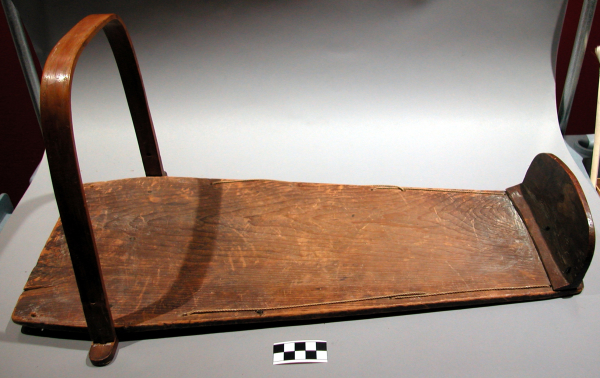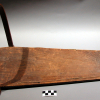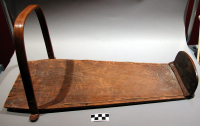káhrhon
káhrhon
káhrhon


Bare wooden cradleboard from the 1900s or earlier. The crossbar and the foot rest are fastened to the body of the cradleboard with metal screws. The body of the cradleboard is corded along edge holes.
The Peabody Museum's database lists the cradleboard's culture of origin as Iroquois.
The Peabody Museum's database.
Read More About This Relative
Wood, twine, metal and cord.
The twine (cord) is placed through the cradleboard's (káhrhon) holes along the edge. The crossbar and footrest are fastened to the cradleboard with metal screws. It appears the cradleboard (káhrhon) is missing the fabric that holds the infant.
None.
The Haudenosaunee cradleboard (káhrhon) is longer and more narrow than Ojibway cradleboards. Haudenosaunee artists usually carve and paint cultural motifs on the backs of their cradleboards. Traditional cradleboards served multiple purposes. Its primary purpose was to safely carry the baby on the mother's back while she worked or moved from one place to another. For example, both the mother and her baby would accompany each other while harvesting berries, corn, squash, beans, and medicine. The mother laced the baby into the cradleboard under a protective covering. The covering protects the baby as they travelled through the underbrush and insects. Its secondary purpose was childcare. The cradleboard was used to keep the baby near the mother and placed against the trunk of a tree or hung from a branch. From this vantage point, the baby could watch the mother, the environment, social interactions and the animals. The cradleboard is constructed with a crash bar. This handlebar protects the baby from falls. The cradleboard kept the baby's back and legs straight as a third benefit. (Researched and written by Sheila Wheesk). This cradleboard's (káhrhon) function was as a consumer product for presentation. Then later, it was donated to the Peabody Museum as cultural material.
The date is noted in the Peabody Museum's database.
Provenance
One of the owners was John Nichols. The collector's name is Erminnie A. Smith. Then, the cradleboard was a gift from Byron Harvey III to the President and Fellows of Harvard College, Peabody Museum of Archaeology and Ethnology for material culture.
The Peabody Museum's database.
Harvard College, Peabody Museum of Archaeology and Ethnology. The Classification is Baby Carrier in the Department of Ethnographic.
1984
Peabody Museum's database.
About This GRASAC Record













The Peabody Museum's database lists the cradleboard's origin as North America/Canada and North America/United States.
 Knowledge Sharing Platform
Knowledge Sharing Platform

